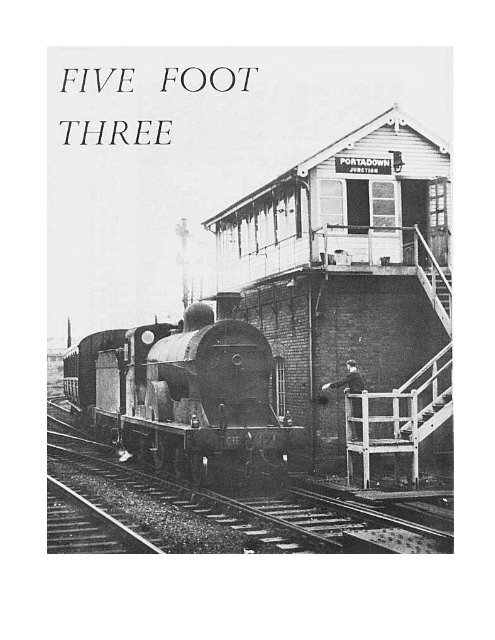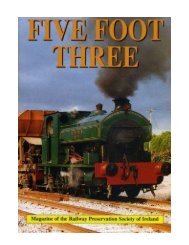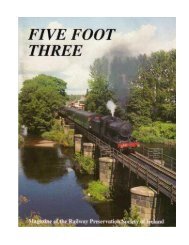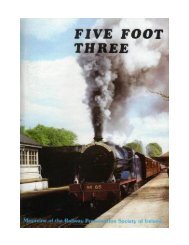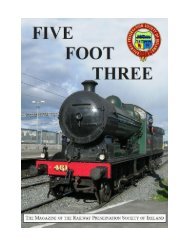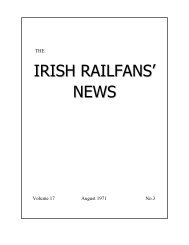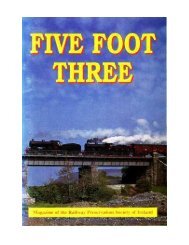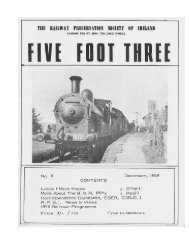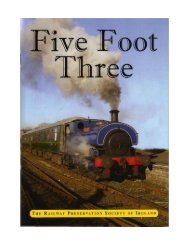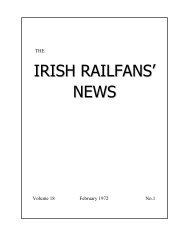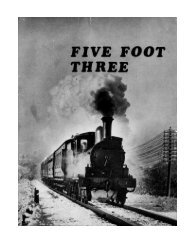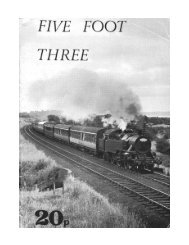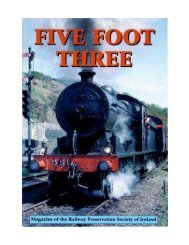Five Foot Three Number 14 - Railway Preservation Society of Ireland
Five Foot Three Number 14 - Railway Preservation Society of Ireland
Five Foot Three Number 14 - Railway Preservation Society of Ireland
You also want an ePaper? Increase the reach of your titles
YUMPU automatically turns print PDFs into web optimized ePapers that Google loves.
CONTENTS<br />
FIVE FOOT THREE<br />
No.<strong>14</strong><br />
Summer 1973<br />
Editor: Charles Friel<br />
Summer Programme 1973<br />
Editorial<br />
News From Committee J.A. Lockett<br />
Site Report J. Glendinning<br />
Locomotive Report P.A. Scott<br />
Membership Matters J. Richardson<br />
Paint Shop A.S. Ragg<br />
Coaching News J. Glendinning<br />
Insurance Notes D. Young<br />
Book Review<br />
Recount R.M. Arnold<br />
First Encounter With 861 Eoin Roe<br />
A Driver Remembers Barney McGirr<br />
My Friend Mr Smyth L.H. Campbell<br />
Letters To The Editor<br />
Opinions expressed by contributors do not necessarily represent those <strong>of</strong> the Editor or the Council <strong>of</strong><br />
the <strong>Society</strong>.<br />
Front Cover: No.171 “Slieve Gullion” eases <strong>of</strong>f the Derry Road and Signalman Graham collects the<br />
single line tablet at Portadown Junction on 9 th August 1963. The train is the 10:25 ex-Derry.<br />
(D.A. Idle)
JUST TEN YEARS AGO - S class 4-4-0 No.60 “Slieve Donard” (formerly GNR 172) at Aghnamara<br />
on the shore <strong>of</strong> Carlingford Lough with the 2pm Belfast to Warrenpoint on 11 th August 1963.<br />
(D.A. Idle)<br />
SUMMER PROGRAMME 1973<br />
7 th July STEAM GALA at Whitehead Excursion Station. Noon - 6pm.<br />
<strong>Three</strong> locos in steam plus attractions for all the family.<br />
Sundays In July & August STEAM TRAIN RIDES at Whitehead 2pm - 6pm.<br />
28 th July, 4 th ,18 th & 25 th August PORTRUSH FLYER See separate leaflet for details. On 18 th<br />
August we hope to run No.171 and have an afternoon run to Derry<br />
and back. Ask for details.<br />
15 th & 16 th September THREE RIVERS RAILTOUR Two engines and 300 miles <strong>of</strong> steam<br />
for about £7 basic Dublin - Wexford - Rosslare - Waterford<br />
(overnight) - Kilkenny - Dublin, with New Ross and Ballinacourty<br />
goods only branches. Plenty <strong>of</strong> photographic opportunities with<br />
runpasts, lineside buses, train splitting, etc.<br />
Connections from English centres, hotels booked, etc.<br />
. . . NON-MEMBERS ARE WELCOME TO ALL RPSI EVENTS . . .
Saturated J15 0-6-0 No.134 on 12:30 Port Laoise-Waterford goods on 9 th July 1955. The <strong>Three</strong><br />
Rivers Railtour will include this station. (R.M. Arnold)<br />
EDITORIAL<br />
All through its history our <strong>Society</strong> has been very different from most societies across the water - indeed<br />
we seem to be an amalgam <strong>of</strong> several features <strong>of</strong> other bodies. We don’t have a line <strong>of</strong> our own but<br />
then the lines all over this island are open to us whenever we wish (within reason). For many years we<br />
were the only body operating main line steam on main lines but recently our contemporaries in England<br />
have been allowed the freedom <strong>of</strong> the open road. Or have they?<br />
Thanks to a much more sensible attitude by BR many excellent events have already taken place using<br />
the cream <strong>of</strong> preserved steam.<br />
But for those from <strong>Ireland</strong> who sampled some <strong>of</strong> these tours last year there was a marked lack <strong>of</strong> the<br />
facilities normally taken for granted on this side <strong>of</strong> the Irish Sea. There were no runpasts, lineside buses<br />
or train splitting, no false starts or posing on viaducts, while the photo stops were few (if at all) and<br />
seemed to be decided upon with a minimum <strong>of</strong> imagination. Now while these tours are excellent in<br />
themselves, they did bring home forcibly just how grateful we in <strong>Ireland</strong> should be for the facilities so<br />
readily made available. That our members and friends in England do appreciate the opportunities to be<br />
had on Irish tours is evidenced by the large, faithful contingent who make the long journey to each <strong>of</strong><br />
our trips; indeed without their patronage many <strong>of</strong> our tours would not have run.<br />
If our tours are out <strong>of</strong> the ordinary, then surely this year’s running <strong>of</strong> the Portrush Flyer should make us<br />
even more ‘unusual’ for here we will have not only a complete preserved train on the main line but<br />
operating a timetabled train as well!<br />
However, if we are to carry out this ambitious plan we will all need to work pretty hard winning<br />
bookings and laying some solid foundations at Whitehead in the form <strong>of</strong> carriage sidings and a coaling<br />
ramp as well as getting together a competent team to clean and maintain the coaches required. This will<br />
be everyone’s chance to play a really active part in running the nearest thing to a ‘proper’ steam train<br />
yet attempted by preservationists in these islands - recreating perhaps the most flamboyant facet <strong>of</strong><br />
steam operations in its last years, the public excursion.
It only remains now for all <strong>of</strong> us to pull together well enough to make the venture the success it surely<br />
deserves to be.<br />
NEWS FROM COMMITTEE J.A. Lockett<br />
The rapid expansion <strong>of</strong> the <strong>Society</strong>’s activities in the running <strong>of</strong> the Portrush Flyer, as well as the<br />
‘normal’ railtour programme and in the acquisition <strong>of</strong> coaching vehicles has given the Committee much<br />
to discuss and act upon.<br />
Dates and prices for the Flyer have at last been finalised with NIR and a brochure was circulated to<br />
members and interested parties. All that remains is for members to sell the seat space to their friends,<br />
families, work-mates, etc.<br />
On the tour front negotiations are in hand for the running <strong>of</strong> a connecting steam train to the Steam Gala<br />
on 7 th July.<br />
The imminent purchase <strong>of</strong> coaches from CIÉ has led to the launching <strong>of</strong> a coach appeal among the<br />
members, the money to be used in the purchase, restoration and protection <strong>of</strong> suitable vehicles. Sam<br />
Carse, our Dublin Representative, is taking charge <strong>of</strong> the discussions with CIÉ. Meanwhile, NIR<br />
<strong>of</strong>fered us the Directors’ Saloon No.150 for purchase. Subsequently, the Northern <strong>Ireland</strong> Tourist<br />
Development Association kindly bought the vehicle and donated her to the <strong>Society</strong>, and she arrived in<br />
Whitehead on Friday 6 th April.<br />
GNR Directors’ Saloon No.50 with U class 4-4-0 No.67 “Louth” (GNR 202) above Goraghwood on<br />
the Benson inspection train in 1963. The steam in front <strong>of</strong> the loco is from a goods going down the<br />
Point line. (I.C. Pryce)<br />
The Committee have been very worried about the lack <strong>of</strong> protected track space at Whitehead especially<br />
following the lucky escape <strong>of</strong> 861 from serious damage. It has now been agreed that the fence should<br />
be extended to include the cutting between our track and that <strong>of</strong> NIR. It has also been decided that one<br />
siding should be laid in the cutting, 330 feet long to hold up to five coaches.<br />
A programme <strong>of</strong> tree planting, mentioned in the last News-Sheet, to improve the amenity value <strong>of</strong> the<br />
Site is under consideration. Due to reorganisation <strong>of</strong> local government it is hoped that our twenty-eight<br />
year lease with an option to renew will be settled in May.<br />
A general reassessment <strong>of</strong> our insurance policies has been found necessary and D.J. Young has given a<br />
lot <strong>of</strong> time to the matter. In connection with this, and to improve the safety <strong>of</strong> workers and visitors<br />
alike, the Committee has appointed I.C. Pryce to be Safety Officer. It has also been decided that all
members should sign an indemnity form. These may be obtained from the Secretary or completed at<br />
Whitehead.<br />
All locos passed their boiler tests but it is felt it will be necessary to re-tube No.171 next winter after<br />
the summer tour programme. It is felt that No.186 will be available for the <strong>Three</strong> Rivers.<br />
Other plans under consideration are the publishing <strong>of</strong> a Supplement to Mac Arnold’s “NCC Saga” to be<br />
published later this year - members will be circulated soon about a special <strong>of</strong>fer involving the Saga and<br />
the Supplement. The purchase <strong>of</strong> a van for the carriage <strong>of</strong> coal from Whitehead to the South for<br />
railtours is also being considered.<br />
Appointments during the period:<br />
Safety Officer I.C. Pryce<br />
Approved expenditure during the period:<br />
Building <strong>of</strong> coaling ramp £6<br />
Extension <strong>of</strong> fence and laying carriage siding £620<br />
SITE REPORT J. Glendinning<br />
Very little work has been done on the Site since the last report as all the available manpower has been<br />
focussed on the coaching stock - a separate report <strong>of</strong> this activity will be found elsewhere in this issue.<br />
Within the next few weeks, however, we will need to greatly increase our manpower if we are to alter<br />
the fence and get the carriage siding down in time for the expected arrival <strong>of</strong> coaches from CIÉ.<br />
The new siding will be laid in the old cutting at the Larne end <strong>of</strong> the site and will be some 300 feet<br />
long. It is expected that it will accommodate up to five bogies and this will greatly ease the shunting<br />
required to make up a train, whether for the Flyer or a tour. When time and money permit some time in<br />
the future a second siding will be added and, very far in the future, there may be a carriage shed.<br />
However before any <strong>of</strong> this can come about we will need a lot more help from members who are able<br />
to spend even a little time at Whitehead, be it once a week or a month. Please do make an effort.<br />
Work on the preparation <strong>of</strong> the cutting should be well under way by the time this appears as Mr John<br />
Duff, the contractor at present working on the new playing fields, has kindly agreed to do the clearance<br />
work at very reasonable cost to the <strong>Society</strong>.<br />
LOCOMOTIVE REPORT P.A. Scott<br />
Over the last three months, work has been concentrated on getting No.171 into a fit state for traffic.<br />
Most <strong>of</strong> the work involved the tender which has lain out <strong>of</strong> use in all weathers since 1966, and from<br />
which many parts had been removed to keep the 4,000 gallon tender running. A lot <strong>of</strong> the work was<br />
straightforward, like replacement <strong>of</strong> brake gear and patching <strong>of</strong> corroded plates, but inevitably some<br />
jobs turned out to be more involved than anticipated.<br />
For a start, the sheet metal turned out to be in a much worse condition than supposed as was soon<br />
revealed when the rust was chipped away. In the end, it was found necessary to replace or patch most<br />
<strong>of</strong> the bottom <strong>of</strong> the well, the front plate, the sloping coal plate, shovel plate and sides and large areas<br />
<strong>of</strong> the top!<br />
Then it was discovered when coupling up the engine and tender that sufficient compression <strong>of</strong> the<br />
springs would be impossible due to wear in the intermediate buffers. In the end it was decided that the<br />
only satisfactory solution would be to make two completely new buffers. The job was done on the lathe<br />
and took nearly two days’ work. The new buffers have the added advantage that they are a good fit in
the guide holes and will reduce the play between engine and tender.<br />
While on the subject <strong>of</strong> buffers, thanks must be expressed to the Transport Museum for “lending” us a<br />
set <strong>of</strong> GN type buffers for the back <strong>of</strong> the tender. The original set was cannibalised for No.186.<br />
On the credit side, we were pleased to find the tender brake cylinder in working order and a set <strong>of</strong><br />
brake blocks which, after a lot <strong>of</strong> head-scratching and adjustment, could be made to bear on all wheels.<br />
Inside No.186’s firebox, Bob Edwards works at<br />
crimping the ends <strong>of</strong> the old tubes. This work is<br />
done under supervision. (C.P. Friel)<br />
Undoing the ravages <strong>of</strong> a winter out <strong>of</strong> doors,<br />
Craig Robb begins the lengthy job <strong>of</strong> preparing<br />
No.171 for her new coat <strong>of</strong> paint. (C.P. Friel)<br />
It was mentioned in the News-Sheet that No.171 would soon require to be re-tubed and in the first<br />
steam test three small tubes were found to be leaking. Indeed, on this particular occasion, the engine<br />
was in a very sorry state - tubes leaking, compression valve joints burst, vacuum ejector not working,<br />
cylinder covers blowing and innumerable joints blowing. Since then matters have improved greatly; the<br />
leaking tubes were plugged in a similar manner to No.186, the blowing joints were remade and the<br />
trouble assailing the vacuum ejector was found to be dirt carried over with the steam clogging the<br />
cones. On Thursday 19 th April, No.171 spent the day shunting the Site and with the proper tender, a<br />
good brake and good coal, she seemed like a different engine. Many people remarked on the better<br />
appearance <strong>of</strong> the small tender; if looks were anything to go by, No.171’s problems would be solved!<br />
Unfortunately, it will require much easy running and adjustment before the gland, axlebox and tube<br />
problems can be confirmed as cured, and before No.171 can be considered a reliable machine and not a<br />
continual source <strong>of</strong> worry.
No.186 is now inside the shed, where the boiler repairs are getting under way. Work has started on<br />
fitting ferrules to the smokebox end <strong>of</strong> the large tubes, in an effort to squeeze a few more years’ service<br />
from them, and the ashpan is being generally repaired and patched. It was found that the front firebar<br />
support had collapsed, thus unintentionally providing the firebox with a sloping grate - not an<br />
improvement since it made the drop gate very difficult to operate. Complete renewal <strong>of</strong> the ashpan will<br />
have to be undertaken within the next couple <strong>of</strong> years.<br />
The tube suppliers have advised that the new tubes are ready for despatch and the re-tubing should start<br />
before this appears in print.<br />
Back in traffic again! No.171 hurries past Whitehead Up advance starter with the King Fergus train<br />
- 861 and Directors’ coach 50 - on 28 th April 1973. (C.P. Friel)<br />
No.186’s smokebox is in a very corroded state and bears many unsightly marks <strong>of</strong> previous patches.<br />
All <strong>of</strong> our engines suffer from this problem in some degree. Perhaps a patched smokebox is less <strong>of</strong> an<br />
eyesore with No.186 than any other engine since she has a “make do and mend” appearance in any<br />
case. However, so much patching is now necessary that we are considering replacing the entire<br />
smokebox shell. This would be a major job and will be undertaken if time is available.<br />
A recent examination revealed that one <strong>of</strong> No.186’s intermediate buffers is broken and the other badly<br />
worn. Both will require to be replaced.<br />
At the time <strong>of</strong> writing, No.4 has not yet had her leading bogie wheels replaced, but the new wheels<br />
have been taken to York Road and we expect the job to be done in the near future. At present No.4 is<br />
having her sanding gear repaired.<br />
STOP PRESS - Just as this issue went to the printers, No.171 worked the “King Fergus” running-in<br />
trip on the Larne line. The loco performed well and no mechanical defects came to<br />
light though the brake problem persists.
MEMBERSHIP MATTERS J. Richardson<br />
The Treasurer reports an encouraging trend in the first three months <strong>of</strong> 1973 - during this time we have<br />
added some thirty new members to our strength and only a few members have so far failed to renew<br />
their subscriptions. One <strong>of</strong> our new members is T. Dorrian <strong>of</strong> Carrickfergus who used to work for<br />
Eastwoods where he cut up some thirty engines. He assures us, however, that like Paul on the road to<br />
Damascus, he has now seen the light.<br />
PAINT SHOP A.S. Ragg<br />
With the prospect <strong>of</strong> tours in late April and early May the “paint shop” has been particularly busy.<br />
No.171 now has her two coats <strong>of</strong> gloss paint, and lining is in progress. This, however, will take some<br />
time to complete. The splasher crests are on, the numbers are on the cab sides and the letters on the<br />
tender.<br />
Some difficulty has been found on the firebox where the paint started to bubble when the engine was<br />
steamed. One section has been stripped (again) and we found a layer <strong>of</strong> dirt underneath (and more blue<br />
paint under that again). By going right down to the bare metal, this problem has been solved. The rest<br />
<strong>of</strong> the bad patches will be tackled when time permits.<br />
Coach 861 marshalled in the Wexford-Rosslare Harbour ‘local’ set at Wexford North in July 1958.<br />
(D.G. Coakham)<br />
COACHING NEWS J. Glendinning<br />
Our coaching stock has recently been augmented by the arrival <strong>of</strong> our second coach, the ex-GNRI<br />
Directors’ Saloon No.50 (latterly UTA and NIR No.150). The vehicle is classed A3 and <strong>of</strong>ficially<br />
seated 22 first class passengers within a fifty two foot body weighing twenty-nine and a quarter tons.<br />
During its ownership by the UTA and NIR the vehicle appeared in a variety <strong>of</strong> hues including dark blue<br />
with a yellow waist band and a sort <strong>of</strong> SNCF vert (green). The vehicle is now in a dull grey. A<br />
preliminary inspection revealed wet rot in several places, probably due to the leaky ro<strong>of</strong> which may<br />
well need re-felting. During her long periods <strong>of</strong> inactivity at York Road, Antrim and Great Victoria<br />
Street, various fittings had been removed and stolen. As a result new light fittings, dynamo and seats
were obtained from condemned vehicles. Only minor restoration has so far been tackled to allow the<br />
coach to run on the King Fergus Railtour.<br />
All other available resources have been channelled into the restoration <strong>of</strong> the Rosslare brake, No.861,<br />
as a safer and more comfortable vehicle. As you may have heard, No.861 was almost destroyed when<br />
vandals broke in and started a fire in one <strong>of</strong> the second class compartments. It was indeed fortunate that<br />
the fire quickly burnt itself out, with damage confined to a hole in the floor.<br />
The first major job to be undertaken was to make the ro<strong>of</strong> waterpro<strong>of</strong> by applying two thick coats <strong>of</strong><br />
bituminous paint. Work then proceeded apace with refurbishing the interior. This involved thoroughly<br />
cleaning each compartment, then applying three coats <strong>of</strong> white paint to the ceiling, two undercoats and<br />
one gloss. The wooden panelling was cleaned down and then given a coat <strong>of</strong> polyurethane varnish. The<br />
seats, however, are particularly bad and the entire coach may need to be reupholstered. Negotiations are<br />
at present in progress with Calor Kosangas to have the gas lighting restored. The other major job being<br />
tackled is the conversion <strong>of</strong> part <strong>of</strong> the large guard’s compartment into a shop. It was found that a<br />
commodious shop and general sales area could be constructed without blocking the corridor in any<br />
way. All the work mentioned has been carried out by a small number <strong>of</strong> members. There is a vast<br />
amount <strong>of</strong> work needed to get the vehicles into first class order and the prospect <strong>of</strong> further coaches<br />
arriving soon makes the job assume gargantuan proportions. Why not come down yourself and make<br />
YOUR contribution, however small? It would be greatly appreciated.<br />
INSURANCE NOTES D. Young<br />
The <strong>Society</strong> has, at present, in force a Public Liability Insurance policy covering the activities carried<br />
on at Whitehead. Briefly, this policy covers the <strong>Society</strong>’s liability for injury caused to any person<br />
legitimately on the Site, or damage to his property.<br />
The liability <strong>of</strong> one member to another is not covered; that is, one member accidentally injuring another<br />
during the course <strong>of</strong> work at Whitehead. It is possible for members to effect individual “personal<br />
liability” policies covering personal injury or damage to property. Members should contact their own<br />
insurance company for details - premiums are modest. This type <strong>of</strong> cover is now also available as an<br />
addition to the “householder” type <strong>of</strong> policy covering the contents <strong>of</strong> a house, and some members<br />
might find that they already have this extension. If not, it can easily be arranged and the premium is<br />
usually less than if a new policy has to be issued.<br />
A personal liability policy would <strong>of</strong> course cover a member at all times, and could nowadays be<br />
regarded as an almost essential addition to complete one’s own personal insurance cover. If one, for<br />
instance, crossed a road carelessly and caused an accident, an action could be taken by the aggrieved<br />
party on the grounds <strong>of</strong> negligence and this policy would provide cover against the ensuing claim. The<br />
word “negligence” is very important.<br />
The <strong>Society</strong> has a duty to take all reasonable precautions to see that its activities are carried out in a<br />
proper, ordered and competent manner, hence the appointment <strong>of</strong> a Safety Officer at Whitehead and the<br />
maintenance <strong>of</strong> accurate records as to attendance, work allocated, reports <strong>of</strong> injuries, etc. Likewise,<br />
members owe it to the <strong>Society</strong> and themselves to ensure that they work safely within the limits laid<br />
down and under proper supervision.<br />
BOOK REVIEW<br />
The Northern Counties <strong>Railway</strong>, Volume One, 1845-1903, J.R.L. Currie, David & Charles, £3.95<br />
At long last the Irish standard gauge is receiving the attention long overdue to it and with this, the first<br />
<strong>of</strong> a promised three part work, Mr Currie draws back the veil on the origins <strong>of</strong> what later became the
Belfast & Northern Counties.<br />
In just over 290 pages, printed with the usual David & Charles spacious feeling, Mr Currie sets out all<br />
the information any student could hope to find about the prospects, personnel and promotion <strong>of</strong> the<br />
various lines. For many, I am sure, accounts <strong>of</strong> Parliamentary Acts, share issues and dividends are<br />
interesting reading but I must say I found these topics just a little hollow when it was so easy to forget<br />
that, while the various events were going on at Board level, there were trains out there somewhere and<br />
<strong>of</strong> these we find unfortunately little mention. Of course the reason partly lies in the fact that engines<br />
and rolling stock items, inter alia, have been reserved for Volume <strong>Three</strong>. Even so the reader can find<br />
some locomotive interest in two excellent early views from the priceless Lawrence Collection.<br />
On a somewhat similar tack, your reviewer found that the more enjoyable passages in the book came in<br />
the ‘mishap’ stories, probably because it is principally in these sections that we get to grips with the<br />
actual trains <strong>of</strong> the period. However, every man to his own taste and I’m sure everyone will welcome<br />
the painstaking chronicling <strong>of</strong> general events which form the main body <strong>of</strong> the book.<br />
Many <strong>of</strong> the illustrations have not been published before and the Lawrence views (<strong>of</strong> which there are<br />
several) are a real delight despite somewhat bald captions. The station views at Derry, Castlerock and<br />
Trooperslane, however, are poorly done - surprisingly as they seem to be recent photographs.<br />
On the whole then this very readable book fills out a well-known outline with much new and<br />
interesting material. Certainly it will be turned to again and again for information on the early NCC.<br />
One cannot help feeling though that with fewer <strong>of</strong> the needless subtitles, the removal <strong>of</strong> several<br />
superfluous cross-references, the editing out <strong>of</strong> repeated information or comments and a smaller type<br />
face, we could have been provided with a concise book priced more within the pocket <strong>of</strong> the average<br />
enthusiast and the general public. It is not unimaginable that all three volumes might well have been<br />
combined in a single book for throughout there are numerous quotations which, while they add a<br />
certain ‘period’ flavour, do little to further the narrative. It would also have made the tale seem less<br />
removed from the actual trains which are, one may suppose, the most important part <strong>of</strong> a railway<br />
company.<br />
RECOUNT R.M. Arnold<br />
A postscript to “Better Than Counting Sheep” in Issue 13<br />
There has been some response to my request for further enlightenment on the subject <strong>of</strong> much travelled<br />
Irish locomotives. The modern idea is to look for trends in everything and I wonder what can be<br />
deduced from the situation that only one person in Northern <strong>Ireland</strong> took the trouble to comment.<br />
From England came the comment that the last paragraph <strong>of</strong> my article was “insufferable cant”. More<br />
constructive was a long letter from David Murray who took me to task, and justifiably so, for omitting<br />
the DSE main line when stating that GS&WR 4-4-0s seldom left their own territory. The only excuse I<br />
can make for this lapse <strong>of</strong> thought is that it may have been a mental adjustment to a tendency in another<br />
Irish railway periodical to give the Dublin, Wicklow and Wexford undue prominence. Certainly I now<br />
hasten to confirm personal recollection <strong>of</strong> recording performance <strong>of</strong> various Inchicore types between<br />
Bray and Wexford. As far as the 4-4-0s are concerned these included classes D4, D10 and D<strong>14</strong> and for<br />
the record J15 <strong>of</strong> both saturated and superheated types amongst the 0-6-0s which also included some<br />
very free running J4 and J9 engines.<br />
Mr Bergin, also <strong>of</strong> Dublin, cautiously doubts my conjecture about Howth and the U class and I am<br />
indeed at fault here also, though not possibly in the grand manner <strong>of</strong> one prominent Irish writer who<br />
thought all the U class had been withdrawn in the “thirties”. Certainly indeed CIÉ may have been<br />
somewhat embarrassed by its allocation <strong>of</strong> four such 4-4-0s in good running order and 197, 199, 203
and 204 may all have gone out to Howth during those rather depressing days, my excuse indeed for the<br />
lapse, for I tend to think <strong>of</strong> the Great Northern as finishing in every respect after September 1957.<br />
Further on this point Mr R.N. Clements has mentioned to me that he has a run with 199 on the<br />
Oldcastle branch between the wars.<br />
FIRST ENCOUNTER WITH 861 Eoin Roe<br />
The <strong>Society</strong>’s Eblana Railtour on 7 th October last must have been a difficult thing to organise - just<br />
how much more can one do with the Northern main line using No.186? However, the sequel to that<br />
tour has provided the present writer with enough enjoyment to spur him to record it in print.<br />
A coach similar to 861 (identification is uncertain) is seen above with J19 606 at Portarlington<br />
before working the 11am connection to Athlone out <strong>of</strong> the 9:35 Dublin-Waterford (via Port<br />
Laoghise) on 23 rd April 1954. The loco is ex-MGWR L class 68 “Mullingar”. (R.M. Arnold)<br />
We arrived in Dundalk very late indeed, having got out <strong>of</strong> path in the earlier stages <strong>of</strong> the day, through<br />
no one’s fault really and the accumulating delays left us very late into Dundalk. There was no light and<br />
very few passengers left to make the Irish North bit <strong>of</strong> the tour worthwhile, anyway I feel it was<br />
mutually forgotten in the event. Those who really wanted it travelled on the footplate or in the<br />
<strong>Society</strong>’s first coach, ex-Rosslare 1 st /3 rd brake No.861.<br />
This vehicle was built in 1907 for the Rosslare-Cork express which radiated connections to Limerick<br />
and Dublin (via Kildare). It is sixty-six feet long with a clerestory ro<strong>of</strong> and gas lighting. The brake end<br />
is commodious and would lend itself readily to shop duty while the compartments, <strong>of</strong> which there are<br />
seven, are entered by hinged doors, none <strong>of</strong> your modern sliding things. The vehicle spent her last years<br />
on the Inchicore works train, plying between Inchicore and Kingsbridge with another elderly vehicle at<br />
times to suit the shifts and hauled by anything handy about the yard. She is painted purple <strong>of</strong> sorts with<br />
a deep orange band along the waist and has been renumbered 484A in the Departmental Stock. Her<br />
condition is really incredibly good for a coach that has been in service for so long, some <strong>of</strong> it with the<br />
least <strong>of</strong> maintenance or care - surprisingly there is only one broken window; there are few vehicles in<br />
service in the North now with such a good record.<br />
As I said, we arrived late in Dundalk and while No.186 shunted <strong>of</strong>f the Eblana stock and slipped down<br />
past the Central cabin to pick up 861 (which had arrived there by goods train), the sizeable contingent<br />
<strong>of</strong> northern members coaled their own fires at the buffet, downing as many sandwiches, cups <strong>of</strong> tea and<br />
bars <strong>of</strong> chocolate and other refreshments as time would allow. All too soon for some, the guard came in
and announced that if we didn’t look sharp and get away now, we’d have a long wait for the section.<br />
Hurriedly the party entrained in the one-coach train, near the Customs counter on Platform One. A<br />
pr<strong>of</strong>usion <strong>of</strong> Tilley and hurricane lamps were persuaded to life as we bundled ourselves and our<br />
belongings aboard amid a great flurry <strong>of</strong> whistling, slamming doors and shouted farewells to some<br />
southern members on the platform who seemed to regret not being able to come with us.<br />
With a final whistle from the stationmaster and rattle <strong>of</strong> lowered mile post windows, the train lurched<br />
away and we were <strong>of</strong>f - the first complete RPSI train. With such a light load, No.186 made a very<br />
speedy departure from the platform on the start <strong>of</strong> her long journey to Whitehead. Soon the last<br />
backward waves were over, the bright lights <strong>of</strong> the station slid behind and gradually the dim light <strong>of</strong> the<br />
compartment took over.<br />
For many <strong>of</strong> those who paid their £10 share for the coach, this was their first look at her but before they<br />
could see very much the eyes had to get used to the low lights. But before long the corridor began to<br />
flicker to life as the occupants began to get to know their new acquisition. The sheer excitement <strong>of</strong><br />
travelling in one’s own coach was at first somewhat intoxicating and the good humour <strong>of</strong> the<br />
passengers was in complete contrast to the despondent dejected people who impatiently paced<br />
Drogheda platform a few hours before, the tour falling apart as they waited for a path. The clerestory<br />
ro<strong>of</strong>, the gas lights (complete with swinging pool <strong>of</strong> black water in the bottom <strong>of</strong> the glass bowl) and<br />
the upholstery all came in for attention - in one compartment we found a notice announcing that<br />
passengers could alight at Inchicore and Kingsbridge only! Over by the windows the timers were hard<br />
at work, writing and watching by the light <strong>of</strong> bicycle lamps or even candles and the twelve wheels <strong>of</strong><br />
the coach set up an unusually rapid rattle as we bowled along in the darkness climbing through<br />
Mountpleasant towards Moyra Castle and Adavoyle.<br />
Our speed fell away to 24 on the climb but we swooped down on Poyntzpass at an even fifty after<br />
running effortlessly through Cloghoge and rode high above the sea <strong>of</strong> lights <strong>of</strong> Newry, deep in its own<br />
valley oblivious to our passing or to the shower <strong>of</strong> red sparks that flung themselves high and wide<br />
above the glow from the open firebox door when the driver put on steam again after the viaduct.<br />
Our progress continued uninhibited until the Pass where we were to take water. Heaven only knows<br />
what the residents <strong>of</strong> Poyntzpass must have thought when a black steam engine stopped just outside the<br />
range <strong>of</strong> the street lights and was immediately surrounded by men waving hand-lamps and carrying<br />
coils <strong>of</strong> yellow hose which were hurriedly paid out, coupled to a manhole in the road and, following<br />
shouted exchanges between men at the gates and an unseen figure on the tender, the yellow hose began<br />
to swell and straighten as the tender was filled.<br />
Approaching Portadown we let <strong>of</strong>f a long whistle coming in past Tavanagh box and another at West<br />
Street bridge - but there would be no answering whistles from the shed tonight, no wave from the fire<br />
raiser at the Derry Road goods engines in the Back Road.<br />
Getting ourselves and the train through the Customs proved relatively painless - indeed one half <strong>of</strong> the<br />
party were round the engine while the others laid siege to the cabin (and its toilet, for 861 no longer<br />
possesses such). We even managed to pick up a passenger for Whitehead here! The staff at Portadown<br />
should be used to seeing the RPSI invade the place by now, but this coach was something different.<br />
The departure from Portadown was one <strong>of</strong> the highlights <strong>of</strong> the trip. Once we had the signal and were<br />
finally whistled away from the platform, No.186 leapt away with new-found energy and her<br />
acceleration was more akin to a test report in Autocar than a 94 year old engine and a 66 year old<br />
coach. Swinging over the crossover onto the Down line, past the colour light signals already tripped to<br />
red by our passing, and rumbling over the Bann, No.186 barked past the scant remains <strong>of</strong> the old<br />
station towards Seagoe - again a long, long wheep that echoed, faded and died somewhere over the<br />
brightly lit but deserted town. Slowly the friendly glow <strong>of</strong> the oil lamps closed in as we raced for
Seagoe and swept under the new road bridge there, headed up through Kernan, already closed for the<br />
night, and pounded up past McCaughey’s Bridge, curved gently to the right and blew for the automatic<br />
barriers at Drumnagoon.<br />
The climb away from the valley <strong>of</strong> the Bann over, No.186 settled in her stride and the warm moonlight<br />
was all around us, nearly every window on the milepost side was down, still the occasional flicker <strong>of</strong><br />
light in the corridor and the ‘crack’ continued in a constant flow. Rushing past the Boilie, No.186<br />
steadied herself for a run at Lurgan and the bank beyond while the reminiscences <strong>of</strong> previous ‘big’ runs<br />
with bigger trains were fondly retold and mulled over - sad to think those runs would never be repeated<br />
and think how long ago all that was. Someone asked why the world didn’t stay forever at 1964, or<br />
better still 1955?<br />
We swept past Lurgan cabin and the engine was opened just a little for the Dougher climb to Post 94.<br />
The blend <strong>of</strong> noise, smoke, darkness, speed and sheer happiness pervaded all, someone even managed<br />
to comment on CIÉ’s widespread use <strong>of</strong> the re-engined C class without being scowled at. Once under<br />
the motorway bridge, No.186 was given her head and we rushed down on Drumbane gates and past the<br />
small splash <strong>of</strong> light at Moira cabin, the signalman silhouetted waving as we passed and No.186 let <strong>of</strong>f<br />
the first <strong>of</strong> a series <strong>of</strong> wheeps for the automatic gates on the approach to Knockmore.<br />
The engine was finally checked at the Down splitting signal at Lisburn and we rolled to a sedate stop at<br />
Platform Two. Here we were met by a group <strong>of</strong> members and friends who eagerly examined 861 as the<br />
engine crew were replaced. We said our farewells to Billy Cr<strong>of</strong>t and Cecil McAdam who handed over<br />
to Billy Gillespie and George Gaw. Another bunk <strong>of</strong> coal was shovelled forward on the tender before<br />
the loco ran round in the teeth <strong>of</strong> an approaching railcar from Portadown which came and went almost<br />
unnoticed.<br />
Before long the Lisburn Up starter near the cabin fell silently, the guard checked the doors and we were<br />
<strong>of</strong>f again. As we gained the Up line, some speculated if we shouldn’t have asked for a photo stop at the<br />
new, and as yet unopened, Knockmore Halt near the Ballinderry Road overbridge - one member <strong>of</strong> the<br />
party even suggested an exposure <strong>of</strong> twenty seconds at f4 for Agfa slides, claiming to have done<br />
something similar in Germany during the summer! But such frivolity was not to be.<br />
Threading our way onto the Antrim Branch, it was soon apparent that the familiar irregular wheel-beat<br />
<strong>of</strong> Sunday School steam days was gone - the branch was being relaid with 60 foot rails on concrete<br />
sleepers, but the Brookmount bank is still there as the sharpening exhaust <strong>of</strong> No.186 soon showed. As<br />
we made our way along we amused ourselves identifying all the locations we had photographed from<br />
during those Sunday afternoons in 1969 when the Northern ballast was steam or, for some, earlier times<br />
spent in frantic chasing <strong>of</strong> empty stock trains and Sunday School specials; Brookhill Post Office,<br />
Ballinderry, Legatariff with its battered coach body on the platform, the tree-lined cuttings near<br />
Glenavy, the viaduct at Crumlin ...<br />
We had arranged to take water at Firmount Bridge, the last overbridge before Antrim, but after a brief<br />
halt at the bridge (much to the surprise <strong>of</strong> the young couple intent on other business at the same place)<br />
the driver decided it wasn’t necessary and we made our way out onto the NCC main line where after a<br />
very snappy run round, a further inspection <strong>of</strong> convenient station plumbing and hurried farewells to a<br />
departing member <strong>of</strong> the party, we set <strong>of</strong>f again, chimney first this time. It was about here that the good<br />
effects <strong>of</strong> Dundalk’s buffet began to wear <strong>of</strong>f and any spare grub was soon disposed <strong>of</strong> as we topped<br />
the bank, thinking <strong>of</strong> No.4’s epic run up here, not falling below 64½ on the climb from an Antrim start.<br />
Our progress was not so speedy though and it was checked at Whiteabbey by a stop to set down a<br />
member <strong>of</strong> the party; even so we made a sprightly run along the Lough shore, past an oddly quiet Shore<br />
Road to arrive in a brightly-lit but deserted York Road.<br />
Here we lost about half <strong>of</strong> the party as No.186 reversed out to a loop and again ran round. It was just
after midnight when we finally got away on the final leg <strong>of</strong> the run. After an easy, unfussed climb to<br />
Bleach Green, we ran quietly through Jordanstown and took Greenisland in our stride. We made our<br />
first stop at Downshire Park and here five more took their leave - the spectacle <strong>of</strong> oil lamps waving in<br />
the night seemed to evoke a wartime atmosphere; someone even struck up with “We’ll Meet Again” as<br />
the train lurched <strong>of</strong>f again along the calm waters <strong>of</strong> Belfast Lough. It was along here that we discovered<br />
that one <strong>of</strong> the company was eighteen that day, but there was only the remains <strong>of</strong> a flask <strong>of</strong> chicken<br />
soup to celebrate with.<br />
As we snaked our way round Briggs Loop the lights <strong>of</strong> the County Down danced across the water<br />
under the starlit sky while the Copelands lighthouse flashed almost unheeded. Members <strong>of</strong> our own<br />
Loco Department began to don overalls and we finalised the arrangements for the bit <strong>of</strong> shunting we<br />
would do that night - pull the Guinness out <strong>of</strong> the shed and then park No.186 and train at the platform<br />
for the night. The Guinness would be used tomorrow to put No.186 away and shunt the stock.<br />
Before we knew it we had run through the station, set back to the cabin and ran into our own premises.<br />
Slowly No.186 clanked the length <strong>of</strong> the Site, then the NIR crew checked her over and handed the train<br />
over to us. Soon the shunting was completed and many tired members bunked down in 861 for the<br />
night. It had been a long day, an historic day and we’d leave the shunting <strong>of</strong> the stock and boarding up<br />
the windows in 861 until tomorrow.<br />
A DRIVER REMEMBERS Barney McGirr<br />
Like many another, ours was a railway family. My father was a passenger guard on the Great Northern<br />
and was transferred from Portadown to Belfast in 1905, where I spent half my life. I spent my first nine<br />
years in Portadown mixed up with engines and trains from an early age and travelled over most <strong>of</strong> the<br />
system in my school days.<br />
I well remember the old small engine shed and the clutch <strong>of</strong> small 0-6-0s that came in to roost in the<br />
siding round Mary Street every weekend. They were engines with long name plates about half the<br />
length <strong>of</strong> the boiler, e.g. 29 “Enniskillen”, 55 “Portadown”, or 63 “Londonderry”. As the drivers grew<br />
older and their beards grew longer, their engines grew older with longer funnels. In later years a clean<br />
shaven driver was likely to be asked by a joker, “If you’re a driver, where’s your beard?”<br />
I joined the Loco Department at Adelaide as a cleaner in 1913, worked my way up to driving,<br />
transferred myself to Omagh in 1940 and finished my driving days there in 1962.<br />
One <strong>of</strong> the first engines I encountered was one shown recently in <strong>Five</strong> <strong>Foot</strong> <strong>Three</strong>, No.12 “Ulster”. She<br />
was one <strong>of</strong> a batch <strong>of</strong> four built in 1911 as express passenger engines with slide valves and extended<br />
smokeboxes which housed the first type <strong>of</strong> superheater on the Northern. A hot water injector was fitted<br />
on the left side <strong>of</strong> the faceplate with two control handles projecting from the side into the driver’s legs.<br />
No.12 was stationed in Dublin and worked the 9:15am express from Amiens Street to Belfast, coal<br />
testing, from 1911 to 1913. The left injector gave lots <strong>of</strong> trouble and had to be ‘booked’ every day. It<br />
was later discarded and replaced with a combination injector the same as the one on the right hand side.<br />
In later years all four engines <strong>of</strong> No.12’s batch (42, 44 and 129 were the others) were rebuilt in<br />
Dundalk with standard size smokebox and boilers with Robinson superheaters, piston valves and a<br />
large cab.<br />
Incidentally, a beautiful model <strong>of</strong> 42 “Munster” in its 1911 livery was on exhibition in the National<br />
Museum, Kildare Street, Dublin in the mid-twenties.<br />
One <strong>of</strong> my first jobs at Adelaide was cleaning on the night shift and the lads I worked with were a jolly<br />
lot. They had no transistor radios like nowadays, but those lads <strong>of</strong> about 20 could make the rafters (or<br />
should I say smoke chutes) ring. They sang all the music hall songs that, like myself, are now referred
to as old.<br />
When No.171 arrived in Adelaide Shed another lad called Graham and myself were booked to clean<br />
the ‘Big One’ for Driver R. Fletcher. In common with the other top drivers, he had his name painted on<br />
the inside <strong>of</strong> the cab. No.171 replaced QL No.24 “Juno”. Adelaide had 171 and 174 while Dublin had<br />
170, 172 and 173. To prevent the superheater tubes being burnt when the regulator was closed, a small<br />
eye with a piston was fixed to the outside <strong>of</strong> the smokebox on the right hand side. The piston was<br />
connected to the steam pipe and operated dampers on the superheater tubes. When the regulator was<br />
open the piston was forced back and lifted the dampers. The dampers and cylinder were found to be<br />
unnecessary and removed.<br />
In 1915 engine No.171 was herself replaced by 192 and I was cleaning her till I was passed as fireman<br />
in 1916. One <strong>of</strong> my first firing turns was on the 11pm shunt and banking engine duty in Adelaide north<br />
end. All the night goods trains had the full load and had to be banked out as far as Dunmurry. Almost<br />
the first seven years <strong>of</strong> my railway life was on night work, starting at 10 or 11pm and finishing at 7 or<br />
8am.<br />
SG class 0-6-0 No.175 (later UTA 43) approaching Lambeg with the mid-day Portadown goods on<br />
23 rd June 1951. (H.M. Rea)<br />
With loads <strong>of</strong> up to 65 wagons, it was sometimes a real wrestling match to get the train out <strong>of</strong> the dip in<br />
the yard. This operation usually involved the driver on the banker blaming the train driver for not<br />
pulling his weight and the train driver blaming the banking driver for not knocking hell out <strong>of</strong> his<br />
engine. If the train engine slipped badly the whole weight <strong>of</strong> the train was thrown on to the banking<br />
engine and this was like running into a solid stop block - if you were standing unprepared you could be<br />
hurt. A bad slip on the part <strong>of</strong> the banker could break a coupling or a draw bar. The banking engine was<br />
not coupled to the train and carried a white head light and a red tail light. Before stopping at Dunmurry,<br />
we had to let the train engine gradually lift the full weight <strong>of</strong> the train. Once the goods was safely away<br />
we crossed over to the Down line, stopped at the Down platform and reversed the lamps.<br />
One night before we left Adelaide my driver told me he had reversed the lamps and this would save me<br />
having to do so at Dunmurry. So this dark night we got to Dunmurry and got the train away all right.<br />
Then we checked the Down signal, found it was <strong>of</strong>f, and set back. But what we didn’t realise was that<br />
the signal was for another Down train which was running late and that the crossover had not been<br />
changed. So we set <strong>of</strong>f through the station and proceeded - the wrong way - along the Up line.<br />
Normally I would have noticed our position when I got out onto the platform to change the lamps, but
this night there were no lamps to be changed. We passed through Finaghy without noticing anything<br />
but as we got near Balmoral I noticed two white spotlights following us. The lights got nearer and<br />
nearer and I leaned out to see what it was. It was the Down train!<br />
As it turned out the Dunmurry signalman had been ringing and shouting all over the place and the<br />
Balmoral signalman would have stopped us anyway - but that was the biggest shock I had in all my<br />
years <strong>of</strong> experience.<br />
In 1919 I was one <strong>of</strong> a group <strong>of</strong> railwaymen who formed the first branch <strong>of</strong> ASLEF in Belfast. Before<br />
this railwaymen were in the NUR but soon we had ASLEF members all over the country - I’m the last<br />
survivor <strong>of</strong> that group <strong>of</strong> men.<br />
About that time too I moved from the banking loco to firing on one <strong>of</strong> the Dublin goods trains which<br />
ran to three trains every night in those days. We had extra traffic because the tramp steamer which<br />
plied between England and Dublin had been sunk in the war and all the traffic for the South came<br />
through Belfast.<br />
S2 Class 4-4-0 No.192 is seen here unnamed in unlined black livery at Adelaide about 1916. Barney<br />
McGirr, whose article appears in this issue, is standing in the right foreground. The blanked-<strong>of</strong>f<br />
remains <strong>of</strong> the damper mentioned in the article can be seen behind the chimney. According to legend<br />
Driver Fletcher hid on the far side <strong>of</strong> the engine while the photograph was taken. See how many<br />
differences between 192 and 171 you can spot. (Isaac Griffith collection)<br />
The trains leaving Belfast would be anything up to 65 wagons. The first and second goods were express<br />
and the third a pick-up. Each train made its first stop in Portadown (1 hour 20 minutes) and while the<br />
pick-up stopped almost everywhere and took from 8½ to 10 hours, the expresses stopped only at<br />
Portadown, Dundalk and Drogheda.<br />
At Portadown the load was lightened for the Wellington bank between Goraghwood and Dundalk. Up<br />
the bank was always a slow slog, going up all the time and it was usual to slip to a stand after running<br />
out <strong>of</strong> sand. We got to know several landmarks on the way up the bank - the Egyptian Arch and Father<br />
Murphy’s bridge (where the line crosses the main Dublin road) so called because this was the name <strong>of</strong><br />
the priest at the nearby chapel when the bridge was built.
The driver with me all the time was Jack Tinman from the Donegall Pass. Tinman and I got to know<br />
one another very well, being together so <strong>of</strong>ten. He would be talking away all the time going up the<br />
bank, which he called ‘the long haul’. If the engine gave a couple <strong>of</strong> slips, Tinman would say, “That’s<br />
Father Murphy and his mountain dew (poteen). When we get to Dublin I’ll report him to the<br />
Archbishop and have him transferred to Tralee - or reduced.”<br />
Traffic got so heavy around this time that Glover in Dundalk was complaining about his engines being<br />
abused so much, and he demanded a banker for the goods. This made life easier for us because the<br />
engine that banked a north-bound train out <strong>of</strong> Dundalk to Goraghwood came in behind us to help us up<br />
the hill. Curiously enough the name <strong>of</strong> the Dundalk driver was none other than Johnny Murphy.<br />
If we got into difficulties on the bank, Tinman would maintain that there was some sort <strong>of</strong> conspiracy<br />
afoot. He would say, “That fella must be a brother <strong>of</strong> Father Murphy and between the two <strong>of</strong> them<br />
they’re out to hang me!”<br />
When working the pick-up goods we usually got into Dublin about eight but, if we got caught behind<br />
the local trains, it could be about nine or half nine. Then, after sleeping in Dublin, we usually would<br />
take the 11:15pm goods back to Belfast with the same engine, which was usually C class No.178.<br />
Tinman was a great man for feeding, and in Dublin he usually bought a load <strong>of</strong> beef and onions. Then,<br />
before we set <strong>of</strong>f, he put all this into a small pot and set it up on the faceplate where it was nice and<br />
warm and the meat would slowly stew.<br />
Going across Malahide strand you could feel the spray <strong>of</strong> the salt water on your face. This made the<br />
engine slip <strong>of</strong> course and this meant more work and by the time we made our first stop at Drogheda we<br />
were ready for a feed.<br />
At Drogheda we would pull forwards onto the Boyne bridge while the shunting engine took wagons <strong>of</strong>f<br />
the back <strong>of</strong> the train. The wind out there above the river on a stormy night was fierce. The wind was so<br />
strong that it would lift huge lumps <strong>of</strong> coal <strong>of</strong>f the tender and hurl them down into the Boyne but we<br />
had wooden sides screwed up on the cab sides to keep out the piercing wind.<br />
We had half an hour at Drogheda to make the first tea <strong>of</strong> the night and we would take down the stew<br />
and have a right old feed.<br />
After another stop at Dundalk for water and filling the bunk, we had the Wellington bank to tackle,<br />
with the aid <strong>of</strong> a banker. Jack would start away up the bank very slowly and we would be crawling with<br />
both engines working hard. At that time Guinness in Dublin were sending up a lot <strong>of</strong> porter to the<br />
North and the railway hadn’t enough porter wagons for the traffic. So barrels <strong>of</strong> Guinness were loaded<br />
into flat wagons. The locals around Mountpleasant took advantage <strong>of</strong> the slow moving train to climb in<br />
to the open wagon and throw overboard a barrel to quench their thirst.<br />
Of course with the shortage <strong>of</strong> proper porter wagons the barrels were <strong>of</strong>ten liable to spring a leak but<br />
there were always plenty <strong>of</strong> conscientious railwaymen around armed with beakers, cups and mugs to<br />
make sure the railway’s permanent way wasn’t damaged in any way.<br />
In 1919, I remember, I was firing on the 10:0pm Belfast-Derry goods and I was with various drivers<br />
and engines. At Dungannon we would make a rush for the tunnel at maybe 15 or 20 mph and get into it<br />
and out again as quick as we could. I pitied drivers who suffered from bronchitis for they used to cough<br />
and choke terribly in the tunnel.<br />
One driver I was with used to lap a wet handkerchief round his face and lie down flat across the<br />
footboard with his head out between the engine and tender to breathe the air churned up by the engine<br />
wheels. The whole cab would be enveloped in smoke and steam and if she slipped at all it was terrible.<br />
In fact it was nothing unusual with a small engine to stick in the tunnel. If I thought we were slipping<br />
badly I would put out my hand and touch the tunnel wall to find out if we were moving forward or
stopped. Passenger trains, <strong>of</strong> course, had no trouble in the tunnel.<br />
In 1933 I was transferred to Clones and then to Omagh where I renewed my acquaintance with the<br />
Dungannon tunnel but this time as a driver on the Derry goods between Portadown and Omagh. One<br />
time as we entered the tunnel unprepared and we just got one engine length inside it I was overcome by<br />
fumes and practically knocked unconscious. I just had time to hit the floor and I didn’t know another<br />
thing until we were out <strong>of</strong> the tunnel.<br />
Like the driver I knew in 1919, I had bronchitis. The fireman had just put on coal before we went into<br />
the tunnel. He should have fired well before that and entered the tunnel with a bright red fire and no<br />
smoke. We were at Pomeroy before I recovered properly that night.<br />
For a time in World War Two I was transferred back to Adelaide. I remember the very first night I was<br />
back there the bombers came over and everybody went to the shelter. But everywhere was so full up<br />
that I went to engine No.199 and although it was still warm, I climbed into the firebox and hid there<br />
until the raid was over.<br />
With the raids, a lot <strong>of</strong> people left the city at night and I remember about 300 people crammed into<br />
railcar D at Portadown for all stations to Omagh. Next we were given an engine and train to take to<br />
Omagh. The coal was bad and it was more slate than coal, and while working this train we were<br />
stopped on the Down line on the Bann bridge at Portadown.<br />
The fireman could not break the slab and to get rid <strong>of</strong> it he picked it up and tossed it over the side into<br />
the river. When we tossed it over, it caught a row <strong>of</strong> telephone wires which were low down outside the<br />
girders. We heard the big splash as the lump hit the water and thought no more <strong>of</strong> this. But some little<br />
time later we were ready to couple up to our train but couldn’t get the signal to go. We asked the<br />
signalman what was wrong and he shouted back that there was no connection between him and the<br />
junction. The telephone had gone haywire, he said.<br />
I suddenly thought <strong>of</strong> the slab <strong>of</strong> slate and wondered if it had anything to do with the failure but gave it<br />
no further thought. The railway, however, decided that somebody must have cut the wires and from<br />
that day until the end <strong>of</strong> the war the “B” men were guarding the bridge every night!<br />
MY FRIEND MR SMYTH L.H. Campbell<br />
It was in February 1968 that I first heard that a locomotive was lying in the Harbour engine shed at<br />
Queen’s Quay in Londonderry.<br />
The engine concerned was the last <strong>of</strong> the Port and Harbour Commissioners’ standard gauge shunting<br />
tanks, No.3 “R.H. Smyth”. The engine was built by the Avonside Engine Co. in 1928 and described as<br />
“generally similar to the B6 class 0-6-0 saddle tanks, but with a wheelbase <strong>of</strong> 9 feet and a gauge <strong>of</strong><br />
5 feet 3 inches”. The engine was supplied with an additional set <strong>of</strong> <strong>of</strong>fset buffing and drawgear at each<br />
end for coupling to 3 foot gauge wagons.<br />
The leading dimensions <strong>of</strong> the engine are as follows:<br />
Cylinders <strong>14</strong>” x 22”; Wheels 3’6” diameter; Tubes 126 x 1¾” diameter; Heating surfaces - Firebox<br />
54 + Tubes 476 = 530 square feet; Grate 9½ square feet; Working pressure 160 lbs; Water capacity<br />
800 gallons; Coal capacity 20 cwt; Weight 24 tons empty, 30 tons full; Length 24 ft; Width 8’6”;<br />
Height 11’½”; Smallest curve 150 ft radius; Tractive effort 13,<strong>14</strong>1 lbs at 80%.<br />
The engine’s livery was black and green, lined out in yellow and lettered in gilt, though few traces <strong>of</strong><br />
this paintwork remained when I first encountered the engine.<br />
Before I go on to tell you <strong>of</strong> my ownership <strong>of</strong> the engine I had better recount some <strong>of</strong> its history.<br />
As you no doubt know, the loco spent its working life on the Londonderry Port and Harbour
Commissioners’ lines, a comparatively short railway which ran from the northern end <strong>of</strong> the quays on<br />
the west side <strong>of</strong> the River Foyle (where there was a narrow gauge junction with the Lough Swilly,<br />
immediately outside their Graving Dock passenger station) along the quayside to the Foyle Road<br />
station <strong>of</strong> the Great Northern. The line continued across the River Foyle on the lower deck <strong>of</strong> the<br />
Craigavon Bridge to the eastern bank where there was a broad gauge connection with the LMS (NCC)<br />
at Waterside station and also a narrow gauge junction with the line to Strabane at Victoria Road station.<br />
The Commissioners’ railway was unique in that the trains were made up partly <strong>of</strong> broad gauge and<br />
partly <strong>of</strong> narrow gauge wagons, a state <strong>of</strong> affairs which led to some amusing incidents at Foyle Road<br />
when the drivers forgot there were narrow gauge wagons in the middle <strong>of</strong> the train.<br />
As a matter <strong>of</strong> historical interest, R.H. Smyth was Chairman <strong>of</strong> the Harbour Commissioners from 1927<br />
to 1941, and his family owned Feed Stuff Mills in Strabane and did an extensive business in the North<br />
West.<br />
No.3 “R.H. Smyth” at Londonderry. (L.H. Campbell collection)<br />
By 1968, however, the engine had been out <strong>of</strong> use for several years and when I received permission to<br />
see her, I was informed that she was about to be sold for scrap. I decided to buy her myself in hopes <strong>of</strong><br />
getting her going again. By the end <strong>of</strong> February 1968 the engine was mine and the Harbour<br />
Commissioners kindly agreed to let me keep her in their shed.<br />
Two hectic days were spent removing as many valuable and attractive fittings as possible before I went<br />
to the Far East for fifteen months, with only a photograph <strong>of</strong> the locomotive to look at on the high seas,<br />
and lots <strong>of</strong> time to think up plans.<br />
In May <strong>of</strong> 1969 I returned to Portstewart on leave and began to look for a permanent home for the
locomotive - a problem that I never really solved - and managed to do some work on the engine. I<br />
arranged for some work to be done by Messrs Alexander Brown & Sons <strong>of</strong> Derry. This was in the<br />
nature <strong>of</strong> cleaning the firebox and tubes and testing the boiler which led to the stopping up <strong>of</strong> some<br />
tubes and a large bill.<br />
The original Avonside plates had been stolen from the shed at Derry but following letters in the<br />
<strong>Railway</strong> Magazine and <strong>Railway</strong> World they were eventually traced in England and restored to the<br />
locomotive - one after some interesting correspondence with a solicitor.<br />
I finally decided to purchase a length <strong>of</strong> trackbed <strong>of</strong> the former Derry Central line near Garvagh and<br />
obtained permission to build a large shed. It was when the tenders for this shed started coming in that I<br />
began to wonder if it would be possible to carry on.<br />
The political situation worsened and the loco was moved for greater ease <strong>of</strong> access and safety to a<br />
quarry near Coleraine in August 1971 by the Heavy Haulage Unit <strong>of</strong> Northern <strong>Ireland</strong> Carriers - more<br />
expense!<br />
It became increasingly obvious to me that I would be unable to spend enough time or money on<br />
preserving the engine myself and so it was on 1 st May 1972 that she was transferred to the <strong>Society</strong> for a<br />
nominal £1.<br />
This short account <strong>of</strong> my efforts in the field <strong>of</strong> preservation should serve as a horrible warning to<br />
anyone who considers “going it alone” for without the basic requirements <strong>of</strong> a pit, shed and lots <strong>of</strong><br />
help, not to mention mechanical skill and lots <strong>of</strong> cash, any such attempt seems doomed to failure.<br />
A Closer Look<br />
When the <strong>Society</strong> ‘bought’ “R.H. Smyth” from Mr Campbell he kindly loaned us a file covering the<br />
engine’s history from the inviting <strong>of</strong> tenders in 1928 up to the last repairs made in 1959. The following<br />
notes are based on that file.<br />
Tenders were received in April 1928 and Avonside, <strong>of</strong> course, were successful with their bid <strong>of</strong> £1,848<br />
which just marginally beat that <strong>of</strong> Hudswell Clarke. The other tenders came from the Yorkshire Engine<br />
Company, Hawthorn Leslie, Peckett and Robert Stephenson. The Avonside engine corresponded very<br />
well to the dimensions specified by the Commissioners - except that the cylinders were larger<br />
(<strong>14</strong>”x22”) and the water capacity almost twice the required amount.<br />
Following correspondence between the Commissioners’ engineer, W.E. Huston, and the Company a<br />
few amendments were made to the specifications. Perhaps the principal <strong>of</strong> these was the substitution <strong>of</strong><br />
steel axleboxes, guides and wedges for the proposed cast iron ones. Mr Huston accepted steel instead <strong>of</strong><br />
brass tubes but turned down the Avonside suggestion <strong>of</strong> a steel firebox instead <strong>of</strong> the copper one<br />
originally specified.<br />
The order was placed in June and there then followed correspondence about details and materials.<br />
Avonside tried to convince Mr Huston that delay could be avoided by using steel plate <strong>of</strong> German<br />
manufacture (by Gutch<strong>of</strong>fnungshutte A G <strong>of</strong> Oberhausen). The Commissioners, however, were<br />
determined to use British materials even though the plates had been inspected by Lloyds’ surveyor in<br />
Dusseldorf.<br />
Much <strong>of</strong> the correspondence was carried on through the boiler insurers whose requirements, at times,<br />
seemed to almost exasperate the builders, and <strong>of</strong> the ten alterations initially demanded by the insurers<br />
in the boiler alone, only one was carried into effect. This was the use <strong>of</strong> inspection doors instead <strong>of</strong><br />
tapered plugs above the foundation ring at the corners <strong>of</strong> the firebox.<br />
The insurers had asked for the inspection openings on either side <strong>of</strong> the firebox to be staggered but, as<br />
Avonside pointed out, this would make inspection impossible without removing the saddle tank.
Towards the end <strong>of</strong> July, when Mr Huston was waiting for the final component drawings and the<br />
makers were reassuring the insurers that the valves were properly secured to the boiler, it was decided<br />
to run the new engine the other way round from the other “ones” (sic) and the narrow gauge coupling<br />
had to be repositioned.<br />
Eventually, then, the work got under way in late August and the last details about the paintwork and<br />
position <strong>of</strong> lamp brackets were settled. The boiler was hydraulically tested on 27 th September and held<br />
240 lbs for thirty minutes and a steam pressure <strong>of</strong> 160 was decided upon. The engine was successfully<br />
steamed the following day when she blew <strong>of</strong>f at 170 lbs.<br />
The engine was steamed again on 12 th October for the insurers - the Commissioners had been invited to<br />
send a representative but declined and asked the insurers to act for them.<br />
With the work completed to everyone’s satisfaction the engine left Bristol on 19 th October and was<br />
shipped from Heysham on the 24 th accompanied by an Avonside mechanic. The engine was sent<br />
completely erected except for the cab which was removed for lifting purposes. The loco arrived on<br />
Sunday 28 th October 1928 and one could do no better than quote the report sent to the General Manager<br />
<strong>of</strong> the Commissioners by Mr Huston.<br />
“The new locomotive ordered from Avonside arrived here on Sunday last and was safely landed on the<br />
rails using the 50 ton steam derrick. Some fitting had then to be done and the trials were proceeded<br />
with on Tuesday 30 th and have continued to date. On Tuesday a rake <strong>of</strong> 36 loaded wagons weighing<br />
468 tons and about 240 yards long was hauled along the quays to the Great Northern <strong>Railway</strong> on wet<br />
and greasy rails and round curves and reverse curves. The same evening 19 <strong>of</strong> these wagons were<br />
hauled up the bridge slope - a gradient <strong>of</strong> 1 in 64. I consider these tests very severe and the locomotive<br />
carried them out satisfactorily. I also tried the locomotive around all the worst curves which were<br />
negotiated without difficulty. Since then the locomotive has being doing the ordinary shunting<br />
efficiently worked by our own men. Some difficulty was experienced at first by the fireman in the<br />
management <strong>of</strong> his fire as the firebox is lower than that <strong>of</strong> the old engine, but he has got quite used to it<br />
now. I have had to get some slight alterations made to certain fittings and I may have to adjust the<br />
narrow gauge buffers when the Engine has settled down on its bearings, but this is not a serious<br />
matter.”<br />
By mid-November all was not well with the lubricator and Mr Huston wrote to Avonside in hopes that<br />
they would recommend an oil considering that the engine normally travelled at “only about two miles<br />
per hour”. He also reported that the regulator was “so stiff as to be almost unworkable” and that the<br />
engine was drawing air around pipes at the bottom <strong>of</strong> the smokebox. Mr Huston asked for advice, too,<br />
regarding the quality <strong>of</strong> coal to be used, quoting that the Commissioners used coal from Auchincruive<br />
in Ayrshire.<br />
Perhaps not surprisingly Avonside knew little <strong>of</strong> this coal but suggested that excessive spark throwing<br />
could be cured by boring out the blast pipe orifice to 3 5 /8 inches. After detailing the operation <strong>of</strong> the<br />
mechanical lubricator, Avonside suggested repacking the regulator stuffing box and recommended<br />
Wakefield oil. It appears that the nameplates were not supplied until late in November when Avonside<br />
suggested where they should be mounted.<br />
It was about the same time that the bill for the engine came to hand. The final total was £1,916.18.0 and<br />
Mr Huston queried the £16.18.0, deferring payment <strong>of</strong> it until matters had been resolved. Several<br />
alterations and repairs, apparently, had had to be made (including a defective narrow gauge coupling<br />
which broke during shunting). By January 1929 a list <strong>of</strong> the alterations made to No.3 was furnished to<br />
Avonside, the cost <strong>of</strong> these was to <strong>of</strong>fset the disputed £16.18.0. Among other things the rail guards had<br />
to be altered, a fusible plug had to be renewed (it dropped at 100 lbs) and the time <strong>of</strong> the fitter dealing<br />
with the stiff regulator allowed for (nineteen hours!).
Surprisingly by April 1931 two <strong>of</strong> the tubes had failed and had to be stopped up and a sample <strong>of</strong> old<br />
tube was sent <strong>of</strong>f for Avonside’s comments. Unfortunately there is no further information on this<br />
subject. But by October 1931 the long series <strong>of</strong> letters about breaking springs began and continued until<br />
mid-1934 when the problem was cured by fitting “trailing springs <strong>of</strong> increased flexibility and<br />
adjustable spring hangers at the trailing end”.<br />
There is a gap in the records for the next ten years and nothing <strong>of</strong> great interest is recorded until 1948<br />
when the engine was stopped for an overhaul which lasted from mid-March until the end <strong>of</strong> July,<br />
although time was spared for “fitting up the new stove in the shed”.<br />
In April 1950 the engine was stopped again and underwent another long period <strong>of</strong> inactivity when the<br />
motion received an extensive overhaul - part <strong>of</strong> which involved attention to the wheels in the Lough<br />
Swilly’s shops. It wasn’t until the middle <strong>of</strong> the following January that the engine was again in steam.<br />
After that the engine seems to have enjoyed a long period <strong>of</strong> activity with little booked against her in<br />
the way <strong>of</strong> repairs. The only entry <strong>of</strong> note in the log is on 7 th May 1959 - “Removing narrow gauge<br />
buffers”.<br />
The latest boiler report is dated 21 st November 1956 when it was recommended that the tubes be<br />
renewed although there is no note <strong>of</strong> this having been done.<br />
One matter which is not really resolved in the file is the date when the engine went out <strong>of</strong> use. An<br />
outside source has quoted 1951, though it is quite clear from the notes available that repairs were still<br />
being carried out as late as January 1959 when the engine was steamed after a week-long repair job.<br />
But one thing abundantly clear from the file is the complex nature <strong>of</strong> buying and maintaining a steam<br />
engine, even in the more favourable conditions <strong>of</strong> the 30s and 40s when spares were available and there<br />
were people to turn to with problems <strong>of</strong> oil, coal, lubricators and springs. The exacting nature <strong>of</strong> the<br />
original specifications and the lengthy correspondence with Bristol in an attempt to get things precisely<br />
right indicate a degree <strong>of</strong> care and attention now almost entirely evaporated in a world <strong>of</strong> plastic,<br />
television and diesels.<br />
There are other things to be savoured in the file too. Who nowadays would post a letter from Bristol to<br />
Derry and expect a reply the day after tomorrow? There is a glimpse <strong>of</strong> another world in the letters<br />
from Wakefield Oil quoting “Loco cylinder oil @ 3/6d per gallon or our celebrated Triple Expansion<br />
Cylinder Oil @ 3/8½d per gallon”, and again in the Avonside letterheading with the unpresumptious<br />
address at “fishponds” and which warned that “All quotations are subject to Strike Clauses”. In those<br />
days, too, every order was referred to as “esteemed”. Editor<br />
LETTERS TO THE EDITOR<br />
Better Than Counting Sheep<br />
Dear Sir,<br />
I read with interest Mr Arnold’s article in <strong>Five</strong> <strong>Foot</strong> <strong>Three</strong> and noted that the author was in no doubt as<br />
to whether or not the U class ever penetrated as far as Howth, among other places.<br />
I remember seeing a U class probably, but by no means certainly, No.199 “Lough Erne” running round<br />
her train in Howth one summer evening. It must have been around 1957/58 when I was quite young.<br />
However, I clearly remember seeing a name on the engine.<br />
I regret I cannot be more precise; the engine might even have been taken over by CIÉ at the time.<br />
Perhaps other readers may have much more information and I myself would be delighted to buy any<br />
print <strong>of</strong> a U at Howth or Sutton.<br />
Also, would the <strong>Society</strong> consider preserving an AEC or BUT railcar set which are fast disappearing
from the Irish scene?<br />
As a Dublin member, I would like to take this opportunity to congratulate you on the magazine. Could<br />
someone do an article on the Bundoran Express? This train has always had an air <strong>of</strong> mystery for me,<br />
and I was surprised it wasn’t mentioned in “Mr Magill’s Party”.<br />
Yours, etc.,<br />
Frank Bergin<br />
Dear Sir,<br />
In response to Mr Arnold’s very enjoyable article on widely-travelled engines, I can add one more<br />
place to the list for Jeep No.4, namely, Kilrea. I saw her near Upperlands with a weed-spraying train in<br />
July 1959; the line closed three months later (sic).<br />
Yours etc.,<br />
Bob Hunter<br />
Dear Sir,<br />
I receive the magazines <strong>of</strong> most preservation societies and have read several in the past few weeks. I<br />
must say your latest issue is the most enjoyable by a very long way; your cover photograph, in<br />
particular, is far better than most British journals have had to <strong>of</strong>fer for some time.<br />
Yours etc.,<br />
D.A. Idle<br />
Dear Sir,<br />
As an Englishman I have long since given up trying to understand why the Irish are always squabbling<br />
so fiercely among themselves, and unfortunately this is equally true if for “Irish” I substitute “RPSI<br />
Committee”.<br />
I guess, Mr Editor, that it was a commendable desire on your part not to stifle any criticism, however<br />
unfair, that led you to devote over three pages to that extraordinary letter from your immediate<br />
predecessor, Mr Donaldson. Pity. It is easily the most petty and unpleasant letter to appear in your<br />
columns so far; may it please be allowed to keep that doubtful distinction, for ever?<br />
Then perhaps I, 300 miles away, shall be able to re-create my illusion <strong>of</strong> the RPSI as an organisation <strong>of</strong><br />
enterprising and dedicated volunteers doing an enormous amount <strong>of</strong> valuable work which deserves my<br />
support. Is that illusion, in fact, very far from the reality?<br />
Yours etc.,<br />
David Veltom<br />
Dear Sir,<br />
Not being terribly knowledgeable about Irish railways, I find <strong>Five</strong> <strong>Foot</strong> <strong>Three</strong> gives me a good insight<br />
into the good old days <strong>of</strong> steam, and despite Mr Donaldson’s remarks I think you are doing an<br />
extremely good job.<br />
Yours etc.,<br />
C.J. Kenyon


